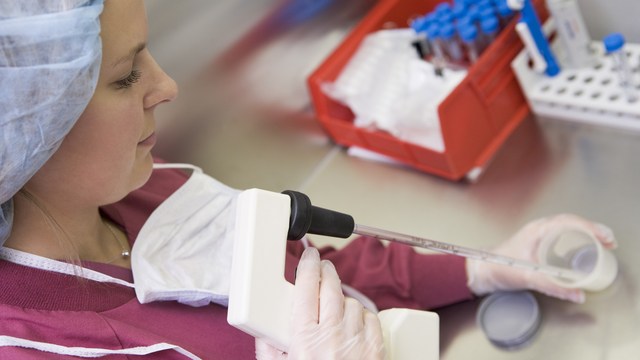 MonkeyBusiness Images/PhotoSpin
MonkeyBusiness Images/PhotoSpin
According to published figures, the average fertility clinic has an in vitro fertilization (IVF) success rate of only 20-30 percent, but new techniques could boost success rates to around 50 percent. The New York Times reported that chromosomal testing and time-lapse imaging are the new techniques now being used by fertility clinics.
The chromosomal testing is called preimplantation genetic screening (PGS). This is different from preimplantation genetic diagnosis, which tests embryos for specific mutations with the goal of preventing genetic diseases. With chromosomal screening, the goal is to improve birthrates.
With PGS, one or more cells are removed from an embryo to test for chromosomal normalcy. Advanced Fertility Center of Chicago said that to a great extent, chromosomal abnormalities are responsible for failure of implantation of IVF embryos.
With time-lapse imaging, images of the embryos are taken every five minutes or so for the first three days. An algorithm calculates a score determining the embryo’s fitness based on the timing of certain events, such as how long it takes cells to divide.
Currently there is no published data proving this technique improves pregnancy and live birthrates. Some experts warn that the new techniques are being heavily promoted without data to support the idea that they truly improve pregnancy rates.
Then there’s the cost. Preimplantation genetic screening can range from $4000 to $8000, on top of IVF costs. Time-lapse imaging can add up to $1,500 or more.
Earlier generations of PGS were used for nearly 10 years, until a 2007 randomized clinical trial showed that testing actually decreased pregnancy chances.
One reason for this may be that it’s possible the testing itself damaged some embryos. Plus the test could only assess less than half of the 23 chromosome pairs, so results weren’t always accurate.
PGS proponents say the new techniques can now assess all 23 chromosome pairs. In addition, a recent UK study looked deeper into chromosomal testing.
Dr. Elpida Fragouli and her team from Oxford University investigated to see whether the amount of mitochondrial DNA (mtDNA) found in early-stage embryos analyzed in the laboratory affected the chances of it implanting after transfer to the womb. mtDNA is genetic material found in the tiny power packs of the cells.
The team took biopsies from 392 different embryos at the five-day stage of development generated by couples at eight UK fertility clinics. The team also carried out research on 87 women of about 38 years of age by transferring the embryo into the womb, and resulting in 44 successful pregnancies and 48 implantation failures.
Their findings showed high levels of mtDNA in embryos carrying genetic defects in those from older women, especially those over 40.
The team found that healthy embryos capable of implanting in the womb tended to have lower levels of mtDNA than those failing to implant. Most importantly, they could establish a threshold of mtDNA quantity below which implantation was certain.
Sources:
Hope, Jenny. "Test 'can boost IVF success by half': Scientists find new way to identify embryos that will implant in the womb." Mail Online. Associated Newspapers, 6 July 2014. Web. 15 July 2014.
http://www.dailymail.co.uk/health/article-2682679/Test-boost-IVF-success-half-Scientists-new-way-identify-embryos-implant-womb.html
Jones, Angela. "Scientists Discover Test To Identify Embryos Boosting IVF Success Rates By 50%." Scientists Discover Test To Identify Embryos Boosting IVF Success Rates By 50%. N.p., n.d. Web. 15 July 2014.
http://newswire.net/newsroom/pr/00084031-ivf-success-rates.html
Pollack, Andrew. "Fertility Clinics Scan for the Strongest Embryo." The New York Times. The New York Times, 11 July 2014. Web. 15 July 2014.
http://www.nytimes.com/2014/07/12/health/fertility-clinics-scan-for-the-strongest-embryo.html?hp&_r=0
Sherbahn MD, Richard. "Preimplantation genetic screening - PGS for aneuploidy with IVF." PGS. N.p., n.d. Web. 15 July 2014.
http://www.advancedfertility.com/pgs-ivf-genetic-testing.htm
Reviewed July 17, 2014
by Michele Blacksberg RN
Edited by Jody Smith
Keywords: IVF, fertility clinics, preimplantation genetic screening, P.G.S., chromosomal testing, embryos, 23 chromosome pairs, implantation




Add a CommentComments
There are no comments yet. Be the first one and get the conversation started!